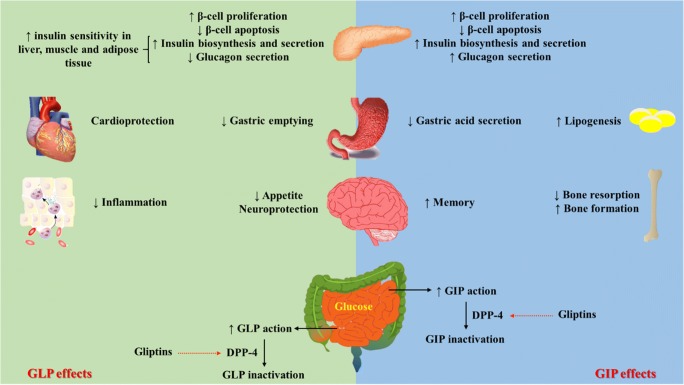Fig. 1.
Glucagon-like peptide-1 (left part) and gastric inhibitory polypeptide (right part) action in peripheral tissues. GIP is secreted from K-cells predominantly located in the proximal small intestine and GLP-1 is secreted from L-cells especially located in the distal ileum [12]. GIP is also expressed in hippocampus and its receptors are detectable in the hippocampus, cerebral cortex and olfactory bulb. It has a role in behavior modification and neural progenitor cell proliferation. Furthermore, the GLP-1 receptors and nerve containing GLP-1 are localized in parts of the brain and regulate appetite, gastric motility, and cardiac function. In the pancreas, GIP and GLP-1 increase glucose-dependent insulin secretion. Besides, GLP-1 inhibits glucagon secretion from α-cells glucose-dependently that reduces the risk of hypoglycemia. GLP-1 also increases insulin sensitivity. It reduces hepatic gluconeogenesis and increases glucose uptake and storage in skeletal muscles. GIP and GLP-1 evoke both lipolytic and lipogenic effects [9, 11]. Surprisingly, GLP-1 attenuates cutaneous inflammation by reducing both lymphocyte migration and macrophage activation, and decreasing cytokine production. It increases regulatory T cells and decreases invariant natural killer T [13]. There is evidence that GIP induces bone formation by stimulating cAMP and increasing intracellular Ca2+ level coupled to increase in alkaline phosphatase activity and collagen type 1 mRNA [9].GLP-1: glucagon-like peptide-1, GIP: gastric inhibitory polypeptide, DPP-4: dipeptidyl peptidase-4

